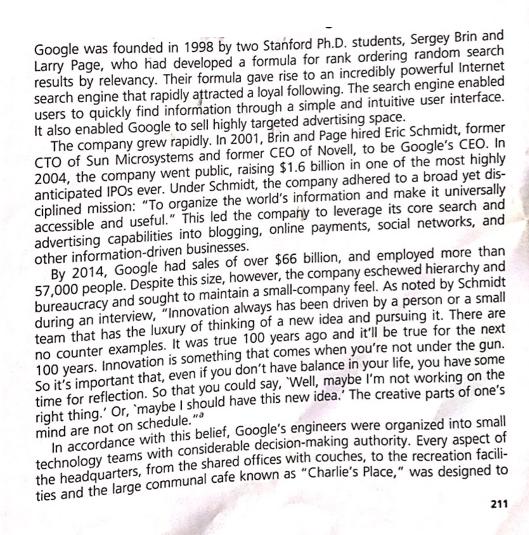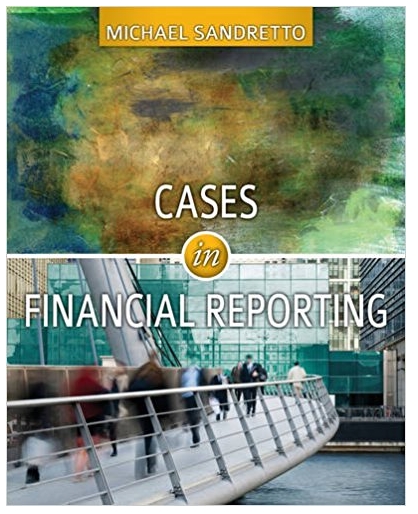Answered step by step
Verified Expert Solution
Question
1 Approved Answer
Google was founded in 1998 by two Stanford Ph.D. students, Sergey Brin and Larry Page, who had developed a formula for rank ordering random



Google was founded in 1998 by two Stanford Ph.D. students, Sergey Brin and Larry Page, who had developed a formula for rank ordering random search results by relevancy. Their formula gave rise to an incredibly powerful Internet search engine that rapidly attracted a loyal following. The search engine enabled users to quickly find information through a simple and intuitive user interface. It also enabled Google to sell highly targeted advertising space. The company grew rapidly. In 2001, Brin and Page hired Eric Schmidt, former CTO of Sun Microsystems and former CEO of Novell, to be Google's CEO. In 2004, the company went public, raising $1.6 billion in one of the most highly anticipated IPOs ever. Under Schmidt, the company adhered to a broad yet dis- ciplined mission: "To organize the world's information and make it universally accessible and useful." This led the company to leverage its core search and advertising capabilities into blogging, online payments, social networks, and other information-driven businesses. By 2014, Google had sales of over $66 billion, and employed more than 57,000 people. Despite this size, however, the company eschewed hierarchy and bureaucracy and sought to maintain a small-company feel. As noted by Schmidt during an interview, "Innovation always has been driven by a person or a small team that has the luxury of thinking of a new idea and pursuing it. There are no counter examples. It was true 100 years ago and it'll be true for the next 100 years. Innovation is something that comes when you're not under the gun. So it's important that, even if you don't have balance in your life, you have some time for reflection. So that you could say, 'Well, maybe I'm not working on the right thing. Or, maybe I should have this new idea. The creative parts of one's mind are not on schedule. " In accordance with this belief, Google's engineers were organized into small technology teams with considerable decision-making authority. Every aspect of the headquarters, from the shared offices with couches, to the recreation facili- ties and the large communal cafe known as "Charlie's Place," was designed to 211 implementing Technological Innovation Strategy foster informal communication and collaboration. Managers referred to Google as a flexible and flat "technocracy," where resources and control were allocated based on the quality of people's ideas rather than seniority or hierarchical status. Schmidt remarked, "One of the things that we've tried very hard to avoid at Google is the sort of divisional structure that prevents collaboration across units. It's difficult. So I understand why people want to build business units, and have their presidents. But by doing that you cut down the informal ties that, in an open culture, drive so much collaboration. If people in the organization under- stand the values of the company, they should be able to self-organize to work on the most interesting problems." A key ingredient in Google's organization is an incentive system that requires all technical personnel to spend 20 percent of their time on innovative projects of their own choosing. This budget for innovation is not merely a device for creat- ing slack in the organization for creative employees-it is an aggressive mandate that employees develop new product ideas. As noted by one Google engineer, "This isn't a matter of doing something in your spare time, but more of actively making time for it. Heck, I don't have a good 20% project yet and I need one. If I don't come up with something I'm sure it could negatively impact my review." Managers face similar incentives. Each manager is required to spend 70 percent of his or her time on the core business, 20 percent on related-but-different projects, and 10 percent on entirely new products. According to Marissa Mayer, Google's head of search products and user experience, a significant portion of Google's new products and features (including Gmail and AdSense) resulted from the 20 percent time investments of Google engineers. wd In a Podcast interview at Stanford University, Andy Grove (former CEO of Intel) remarked that the company's organization appeared chaotic, even noting "From the outside it looks like Google's organizational structure is best described by... Brownian motion in an expanding model and questioned whether Schmidt believed this model would continue to work forever. In his response, Schmidt responded, "There's an important secret to tell, which is there are parts of the company that are not run chaotically. Our legal department, our finances. Our sales force has normal sales quotas. Our normal strategic planning activities, our normal investment activities, our M&A activities are run in a very traditional way. So the part of Google that gets all the attention is the creative side, the part where new products are being built and designed, and that is different. And it looks to us like that model will scale for quite some time... it looks like small teams can run ahead and that we can replicate that model for that part of the company." Discussion Questions 1. What are the advantages and disadvantages of the creative side of Google being run as a flexible and flat "technocracy?" 2. How does Google's culture influence the kind of employees it can attract and retain? 3. What do you believe the challenges are in having very different structure and controls for Google's creative side versus the other parts of the company? 4. Some analysts have argued that Google's free-form structure and the 20 percent time to work on personal projects is only possible because Google's prior suc- cess has created financial slack in the company. Do you agree with this? Would Google be able to continue this management style if it had closer competitors? J. Manyika, "Google's View on the Future of Business: An Interview with CEO Eric Schmidt," McKinsey Quarterly, November 2008. From "The Google Culture," www.google.com. C Manyika, "Google's View on the Future of Business." d B. lyer and T. H. Davenport, "Reverse Engineering Google's Innovation Machine," Harvard Business Review, April 2008. Podcast retrieved on April 13, 2009, at http://innovate.blogspot.com/2007/03/eric-schmidt-ceoof-google.html.
Step by Step Solution
★★★★★
3.36 Rating (149 Votes )
There are 3 Steps involved in it
Step: 1
1Advantages Lack of divisional structure advances coordinated effort crosswise over units Casual ties drive joint effort Assets and control allotted d...
Get Instant Access to Expert-Tailored Solutions
See step-by-step solutions with expert insights and AI powered tools for academic success
Step: 2

Step: 3

Ace Your Homework with AI
Get the answers you need in no time with our AI-driven, step-by-step assistance
Get Started


